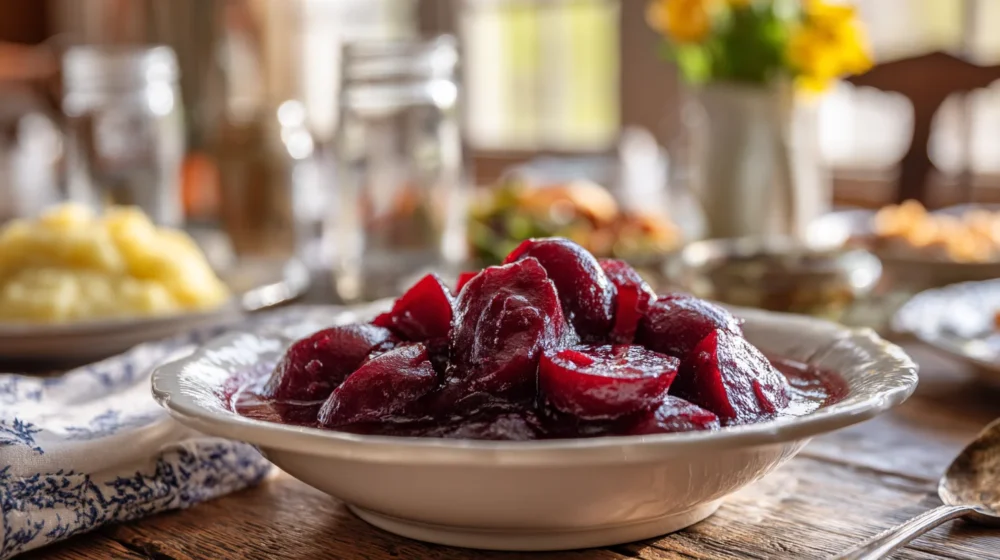
Ingredients
- 2 1/2 pounds fresh red beets trimmed and peeled, cut into bite-sized pieces
- 1 teaspoon kosher salt for cooking water
- 1 cup granulated sugar
- 1/4 cup white vinegar
- 1/2 cup apple cider vinegar
- 1/2 teaspoon kosher salt
- 1/2 teaspoon freshly ground black pepper
- 1/2 cup reserved beet cooking water
- 2 tablespoons cornstarch
- 6 tablespoons unsalted butter
Instructions
- Place beets in a large pot with cold water and bring to a rolling boil. Once boiling, add one teaspoon of salt. Cook for 15 minutes until tender.
- Carefully ladle off and reserve 1/2 cup of the cooking water, then drain the remaining water from the beets.
- Return beets to the pot and add sugar, white vinegar, cider vinegar, salt, and pepper. Stir mixture over medium heat.
- In a small bowl, whisk cornstarch with the reserved 1/2 cup beet cooking water until smooth. Add this mixture to the beets.
- Continue cooking for five minutes over medium heat, stirring frequently, then add butter and stir until completely melted and incorporated into the sauce.
- Remove from heat and serve immediately in individual bowls to prevent staining other foods.
I’ll never forget the first time I tasted Harvard beets at my grandmother’s Sunday dinner table. The gorgeous ruby-red color caught my eye immediately, but it was that first bite that completely won me over. The perfect balance of sweet and tangy flavors, combined with the earthy richness of the beets themselves, created something truly special that I knew I had to learn to make myself.
Growing up in New England, Harvard beets were a staple at every holiday gathering and family celebration. Yet somehow, I never paid attention to how they were made until I moved away from home and found myself desperately craving that distinctive sweet and sour taste that no restaurant seemed to capture quite right. That’s when I called my grandmother and begged for the recipe that had been passed down through generations of our family.
What makes Harvard beets so incredibly appealing is their versatility and the way they transform a humble root vegetable into something elegant enough for the finest dinner party, yet comforting enough for a weeknight meal. The glossy, jewel-toned sauce clings to each piece of beet, creating little pockets of sweet and tangy goodness that burst with flavor in every bite.
The secret lies in the careful balance of ingredients. The sugar brings out the natural earthiness of the beets while the combination of white and apple cider vinegar adds layers of acidity that prevent the dish from becoming cloying. The cornstarch creates that signature glossy coating that makes the beets look like precious garnets, while the butter stirred in at the end adds a richness that ties everything together beautifully.
I’ve experimented with this recipe countless times over the years, and I’ve learned that using fresh beets makes all the difference in the world. While canned beets will work in a pinch, there’s something about the texture and flavor of fresh beets that elevates this dish from good to absolutely spectacular. The slight firmness of properly cooked fresh beets provides the perfect contrast to the silky smooth sauce.
One of my favorite aspects of making Harvard beets is how the cooking process fills the entire kitchen with the most amazing aroma. There’s something about the combination of sweet sugar, tangy vinegar, and earthy beets that creates a scent that immediately transports me back to those childhood Sunday dinners. My own children now associate this smell with special occasions and family gatherings, continuing the tradition that means so much to me.
The preparation process itself has become almost meditative for me. There’s something deeply satisfying about peeling and cutting the fresh beets, watching the deep red color stain my cutting board, and knowing that I’m creating something that will bring joy to everyone at the table. I always wear my oldest apron because beet juice is notorious for staining, but I consider those purple-red splatters to be badges of honor from a job well done.
When it comes to serving Harvard beets, presentation matters almost as much as taste. I learned early on that serving them in individual small bowls prevents the beautiful red sauce from staining other foods on the plate. This also allows each person to savor them properly without worrying about the intense color spreading to their mashed potatoes or dinner rolls.
The timing of this dish is crucial for achieving the perfect consistency. The cornstarch slurry needs to be whisked smoothly to prevent any lumps, and the sauce should be cooked just long enough to thicken properly without becoming gluey. I’ve found that stirring constantly during those final five minutes ensures even cooking and prevents any sticking to the bottom of the pot.
Over the years, I’ve served Harvard beets alongside everything from simple roasted chicken to elegant holiday roasts, and they never fail to impress. There’s something about their vibrant color and unique flavor profile that elevates any meal. Guests often ask for the recipe, and I’m always happy to share it because I believe good food is meant to be passed along and enjoyed by as many people as possible.
What I love most about this recipe is how it connects me to my family’s history while creating new memories with my own family. Every time I make Harvard beets, I think about all the hands that have stirred this same combination of ingredients, all the tables where this dish has been served, and all the faces that have lit up with that first delicious bite.
The leftovers, if there are any, keep wonderfully in the refrigerator and actually taste even better the next day as the flavors have more time to meld together. I often find myself sneaking spoonfuls straight from the container, savoring that perfect balance of sweet and sour that never gets old.
Making Harvard beets has taught me that sometimes the most treasured recipes are also the simplest ones. With just a handful of basic ingredients and some careful attention to timing, you can create something that brings people together and creates lasting memories around the dinner table. That’s the true magic of cooking – transforming simple ingredients into something that nourishes both body and soul.




